
ISWI Events meetings on the subject of ISWI in 2013 year
The list is updated on October 22, 2013
- In 2013 list:
- Tenth European Space Weather Week 18-22 November, 2013, Antwerp, Belgium go to
- Mechanics of the Magnetospheric System and Effects on the Polar Regions October 27 - November 1, 2013, Torres del Paine, Patagonia, Chile go to
- United Nations/Austria Symposium on Space Weather Data, Instruments and Models: Looking Beyond the International Space Weather Initiative (ISWI) 16-18 September 2013, Graz, Austria go to
- IAUS300: Nature of solar prominences and their role in Space Weather, Paris, France 10–14 June 2013, go to
- United Nations/Croatia Workshop on the Applications of Global Navigation Satellite Systems
Baška, Krk Island, Croatia, 21–25 April 2013 go to - 2013 SARA Western Regional Conference Socorro, New Mexico, United States, February 9 - 10, 2013 go to
to see events in 2012 click here
to see events in 2010-2011 period click here
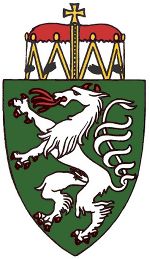
Added on May 22, 2013
The symposium completed successfully.
List of Participants ![]()
Look at presentations
The UN Final Report ![]()
United Nations/Austria
Space Weather Data, Instruments and Models:
Looking Beyond the International Space Weather Initiative (ISWI)
16 - 18 September 2013, Graz, Austria
Hosted and co-sponsored by the Government of Austria,
the State of
Styria and the City of Graz and
co-sponsored by European Space Agency (ESA)
INFORMATION NOTE click ![]()
web link www.unoosa.org/oosa/en/SAP/act2013/graz/index.html
More and more countries are interested in establishing own basic capacities in space technology development and also in access to- and use of diverse space-based data.
In this context, a new Graz Symposium series started in 2012. The new series attempts to address various space-based data analysis and workflows, review data availability and data sharing status as well as future opportunities, with a view to facilitate better and easier access to such data and resulting analytical products for general and wide-scale scientific benefit and also in support of decision making processes. The Symposium series also explores how space-based data and analysis could support the global development and help address or monitor the various sustainable development goals and targets set by the United Nations and its Member States in achieving a sustainable development of our Planet.
This year's Symposium, the second of this new series, will continue covering the Space Weather domain by addressing the global instrument network and related data collections as well as data modeling efforts making use of such data.
In 2012, at the conclusion of the ISWI initiative, a number of recommendations including regular interaction and continuation of international cooperative efforts were made in Ecuador (See A/AC.105/1030,
![]() ). The purpose of this Symposium is therefore to address a need to follow up on the ISWI recommendations related to instrument availability and data modeling opportunities, by bringing together experts from developed and developing countries and most major instrument operators and data sources as well.
). The purpose of this Symposium is therefore to address a need to follow up on the ISWI recommendations related to instrument availability and data modeling opportunities, by bringing together experts from developed and developing countries and most major instrument operators and data sources as well.
Deadline for Submission of Applications: no later than
Submit an Applications ? (click here) (
)
(a) Review as an expert group world-wide existing and planned space weather-related data collection and development activities (space-based and ground-based observations, modeling and forecast development) and identify any gaps
(b) Review international cooperation activities and the role of international cooperation in addressing space weather-related issues, such as possible further cooperation towards a truly global space-weather monitoring capabilities
(c) Identify opportunities for international cooperation in the standardization, sharing and wider, timely use of data, also for operational purposes; data interoperability and formats will be considered, as those are important aspects for any standardization
(d) Review current models repositories and identify some opportunities for international cooperation to identify, create and better share optimized models to produce accurate simulations and predictions, timely forecasts tailored to needs in each country or region of the world
(e) Identify concrete cooperation and knowledge sharing in this domain with other relevant initiatives or consortia. SCOSTEP was already proposed for presentation and discussion
(f) Offer hands-on training possibility for participants in using existing model repositories such as the NASA one in combination with open or own data sources for various applications
2013 Symposium Programme: The Symposium will consist of a series of invited technical presentations by selected experts in the field, with sufficient time set aside for discussions and for presentations by all participants on their own relevant activities. Experts will be primarily sought for covering the Instrument Array status and data collection topics as well as data modelling.
- Sessions will cover:
- Taking stock of existing space-borne and in-situ data collection networks and instrument arrays
- Data processing and data modeling tools, ongoing efforts review, model availability
- Data standardization, data interoperability and data formats
- Special sessions as identified (SCOSTEP, IAA study, etc)
Participants: Applicants must generally have a university degree and well-established professional working experience in a field related to the theme of the Symposium. Applicants should ideally be involved in the planning, implementation or operation of data arrays, in relevant organizations, international or national, research or academic institutions or industry.
close additional text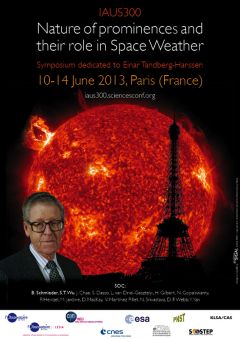
Added on March 06, 2013
Second announcement ![]()
IAUS300
"Nature of solar prominences and their role
in Space Weather",
Paris, France, 10–14 June 2013,
Rationale
The aim of this IAU Symposium is to present a review of the state-of-the-art of the theoretical, numerical modeling, and space-borne and ground-based observational studies of prominences and their role in the dynamics of Sun-Earth relations. It also aims at opening new perspectives for the people, and especially young ones, working in the field. Prominences have an active role in the Space Weather. Magnetic clouds and the Coronal Mass Ejections (CME) associated to erupting prominences can produce severe perturbations in GPS, in telecommunications and for satellites and space inhabited vessels. So it is time to put together the many efforts made to understand their physics in order to be able to make forecasts about their possible impact on our space environment. Moreover, huge prominences and CME have been detected in solar-type stars (and others) and it is interesting to put the properties of solar prominences in a broader perspective, on one hand, and to present the status of the sophisticated solar analysis to the concerned stellar community on the other hand. In summary, we would like to bring together different communities in astrophysics.
Session II "CME, ICME, Space Weather" (key topics 6-7)
6/ Prominence destabilization, CMEs, reconstruction in 3D
7/ CMEs in the heliosphere, Magnetic clouds, Impact on the Earth’s environment
WEB site: http://iaus300.sciencesconf.org/
Contact: iau.s300[at]obspm.fr
Payment The fees (350 Euros) include the venue, 3 lunches, the conference dinner, the proceedings book. For the payment you will be redirected to a secure website. You should wait for an email of validation before paying. Credit cards are accepted. French people can pay via orders.
Financial support and visa
Some grants will be available mainly for students and young researchers. Please fill the form (click ![]() ) and send to : IAU.S300[at]obspm.fr or fax to 33 145 07 79 59 .
) and send to : IAU.S300[at]obspm.fr or fax to 33 145 07 79 59 .
If you need a visa for France, please contact us IAU.S300[at]obspm.fr (with a copy of your passport).
Deadlines
* Decision for IAU financial support: 01 Feb 2013
* Deadline for early registration: 10 May 2013
* Abstract deadline for oral presentation: 15 March 2013
* Decision of the program: 10 April 2013
* Registration and abstract submission for poster(end) 10 May 2013
* Deadline for proceedings submission: 15 Sep 2013
close additional text
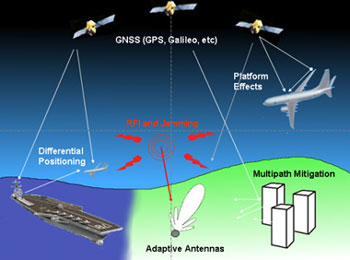
Added on Jauary 12, 2013
United Nations/Croatia Workshop on
the Applications of Global Navigation Satellite Systems
Baška, Krk Island, Croatia, 21–25 April 2013
Introduction
A five-day workshop on global navigation satellite systems (GNSS) technology and its applications in Baška, Croatia, from 21 to 25 April 2013 is being organized by the United Nations Office for Outer Space Affairs (OOSA) in cooperation with the Faculty of Maritime Studies of the University of Rijeka as part of the activities of the United Nations Programme on Space Applications, for the benefit of the countries in Europe. The Workshop will be hosted by the Faculty of Maritime Studies of the University of Rijeka.
GNSS refers collectively to all of the satellite navigation systems in operation or being developed around the world known as the Global Positioning System (GPS) of the United States of America, the Global Navigation Satellite System (GLONASS) of the Russian Federation, Galileo of the European Union and Compass/BeiDou of China. In addition, these systems are supplemented by space-based augmentation systems (SBAS) or ground-based augmentation systems (GBAS). Examples of SBAS are the United States of America wide-area augmentation system (WAAS), the Russian system of differential correction and monitoring (SDCM), the European geostationary navigation overlay service (EGNOS), or the Indian GPS-aided geo augmented navigation (GAGAN) and the Japanese multi-functional transport satellite (MTSAT) space-based augmentation system (MSAS). These systems augment the existing medium earth orbit (MEO) satellite constellations with geostationary (GEO) or geosynchronous satellites signals or other environmental factors, which may impact the signal received by the users. Using several or all of the GNSS satellites in orbit, productivity typically increases as well as accuracy compared to using only one system.
Workshop participants will discuss how GNSS-enabling technology can strengthen a network of national reference stations and promote the interoperability of navigation, positioning and timing systems in the region. An overview of a wide range of GNSS applications existing today and prospects for the future, in areas such as surveying, mapping and asset management, precision agriculture, engineering and construction, aviation and maritime, as well as space weather monitoring will be provided.
"Information note" and "Application FORM" (in PDF and WORD format) were attached to ISWI Newsletter Vol.5 No.3
on-line application form is available here
(
)
Session 1: Current and planned global and regional navigation satellite systems and satellite-based augmentation systems
![]() Programme updates-GNSS: Global Positioning System (GPS Wiki), GLObal NAvigation Satellite System (GLONASS Wiki), European Satellite Navigation System (GALILEO Wiki), COMPASS/BeiDou Navigation Satellite Systems (CNSS Wiki), Indian Regional Navigation System (IRNSS Wiki), Quasi-Zenith Satellite System (QZSS Wiki)
Programme updates-GNSS: Global Positioning System (GPS Wiki), GLObal NAvigation Satellite System (GLONASS Wiki), European Satellite Navigation System (GALILEO Wiki), COMPASS/BeiDou Navigation Satellite Systems (CNSS Wiki), Indian Regional Navigation System (IRNSS Wiki), Quasi-Zenith Satellite System (QZSS Wiki)
![]() GNSS space-based augmentation systems: Wide-Area Augmentation System (WAAS), System of Differential Correction and Monitoring (SDCM), the European Geostationary Navigation Overlay Service (EGNOS), GPS Aided Geo-Augmented Navigation (GAGAN), the Multifunctional Transport Satellite Satellite-based Augmentation System (MSAS)
GNSS space-based augmentation systems: Wide-Area Augmentation System (WAAS), System of Differential Correction and Monitoring (SDCM), the European Geostationary Navigation Overlay Service (EGNOS), GPS Aided Geo-Augmented Navigation (GAGAN), the Multifunctional Transport Satellite Satellite-based Augmentation System (MSAS)
Session 2: GNSS user applications
![]() Space and atmospheric weather: observation of space weather phenomena through the deployment of ground-based world-wide instrument arrays such as GPS receivers, magnetometers, solar telescopes, very low frequency (VLF) monitors, solar particle detectors, and data analysis and the sharing of recorded data
Space and atmospheric weather: observation of space weather phenomena through the deployment of ground-based world-wide instrument arrays such as GPS receivers, magnetometers, solar telescopes, very low frequency (VLF) monitors, solar particle detectors, and data analysis and the sharing of recorded data
![]() New capabilities in efficiency and safety across all modes of transportation: aviation, maritime,
rail and highway
New capabilities in efficiency and safety across all modes of transportation: aviation, maritime,
rail and highway
![]() Applications in surveying and mapping, geodesy, science and timing, environment, agriculture,and remote sensing with GNSS and integrated sensors
Applications in surveying and mapping, geodesy, science and timing, environment, agriculture,and remote sensing with GNSS and integrated sensors
Session 3: GNSS reference station networks and services
![]() Regional and national reference frames/systems implementation
Regional and national reference frames/systems implementation
![]() International GNSS Service (IGS) and other initiatives, multi-GNSS environment
International GNSS Service (IGS) and other initiatives, multi-GNSS environment
Session 4: Capacity building, training and education in the field of GNSS
All Sessions: Discussion Sessions
![]() Issues, concerns and approaches for pilot projects/initiatives, requirements of implementing,
mechanisms and resources of implementing
Issues, concerns and approaches for pilot projects/initiatives, requirements of implementing,
mechanisms and resources of implementing
![]() Possible follow-up projects and initiatives and proposals for future workshops/training courses
Possible follow-up projects and initiatives and proposals for future workshops/training courses
close additional text
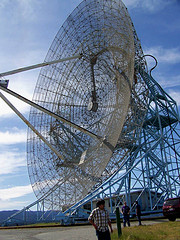
Added on December 17, 2012
Summary Report ![]()
2013 SARA Western Regional Conference
Socorro, New Mexico, United States, February 9 - 10, 2013
The 2013 SARA Western Regional Conference will be held at Best Western Socorro Hotel amp; Suites in New Mexico on Saturday and Sunday, February 9 and 10, 2013. We will have a tour of the Very Large Array (VLA) site west of Socorro. In addition to presentations by SARA members, we plan to have speakers from the National Radio Astronomy Observatory Array Operations Center (NRAO AOC) in Socorro.
Conference web site
look at ISWI Newsleter Vol.4 No.124
The 2013 SARA Western Regional Conference will be held at Best Western Socorro Hotel & Suites in New Mexico on Saturday and Sunday, February 9 and 10, 2013. We will have a tour of the Very Large Array (VLA) site west of Socorro. In addition to presentations by SARA members, we plan to have speakers from the National Radio Astronomy Observatory Array Operations Center (NRAO AOC) in Socorro. Additional details will be published online and in the SARA journal as we get closer to the conference date. Register now to avoid the rush and to guarantee a seat at the conference.
VLA site tour: The Very Large Array consists of 27 parabolic dish reflector antennas in a Y-shaped configuration on the Plains of San Agustin approximately fifty miles west of Socorro: http://www.vla.nrao.edu/. Each antenna is 25 m in diameter. The data from the antennas is combined electronically to give a resolution equivalent to an antenna 36 km across, with the sensitivity of a dish 130 m in diameter. The array has been undergoing an expansion project called the EVLA, or Expanded VLA. The facility also is the home of the Long Wavelength Array (LWA): http://www.phys.unm.edu/~lwa/index.html. The LWA uses many inexpensive antennas to provide a very large aperture. The LWA is designed to probe the depths of space at relatively low frequencies between 10 and 88 MHz. There are 256 antennas in an antenna station and each is a drooping dual-dipole about 1.5 m high and 2.7 m across.
Contact: Please contact conference coordinator Whit Reeve if you have any questions about the conference or if you would like to help: westernconference[at]radio-astronomy.org.
Registration info and other details are here:
http://www.radio-astronomy.org/?q=node/396
The tentative schedule and some abstracts are here:
- Schedule: http://www.radio-astronomy.org/?q=node/401
- Abstracts: http://www.radio-astronomy.org/?q=node/402
close additional text
Added on July 26, 2012

Mechanics of the Magnetospheric System and Effects on the Polar Regions
Torres del Paine, Patagonia, Chile, October 27 - November 1, 2013
We are glad to announce the third international conference on hot topics of magnetospheric physics, which will be held in October 2013, in the region of Torres del Paine, close to the city of Punta Arenas, Chile.
Conference web site
look at ISWI Newsleter Vol.5 No.80
The main objective of the conference is the discussion of some of the outstanding questions in magnetospheric physics and to emphasize the system aspects of its behavior.
Topics to be considered:1. Physics of solar-wind/magnetosphere coupling.
2. Energy and mass flow into and through the magnetosphere.
3. Timescales and time lags in the magnetosphere-ionosphere system.
4. Magnetosphere-ionosphere feedback.
5. The polar cap and the auroral zone.
6. Geomagnetic storms.
7. Turbulence and self-organization.
8. Statistical techniques and mathematical models.
9. Scaling laws.
Read more...The conference site will be Hotel Rio Serrano, at Torres del Paine in Puerto Natales, Chile. The hotel website is www.hotelrioserrano.cl/home_en.html
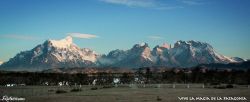 Important dates
Important dates
April 30, 2013 Abstract Submission Ends
June 13, 2013 Registration Begins
August 1, 2013 Early Registration Ends
Early registration fee (deadline August 1, 2013): Participants: US$500; Students: US$350; Accompanying persons: US$350
Late registration fee (after August 1, 2013): Participants: US$550; Students: US$400; Accompanying persons: US$400
Registration fee includes transportation from/to Punta Arenas, Full Day excursion to Torres del Paine and the conference Dinner.
Important information regarding Visa requirements: The absolute majority of countries do not need visa to go to Chile. However, the citizens of the US, Canada, Mexico and some other countries need to pay the reciprocity fee in the Airport (US160 for US citizens). However, if you already paid it in a previous trip to Chile and you keep THE SAME PASSPORT, you only need to show the stamp in the passport that you did it. The list of requirements for each country can be found here. (See the column Req. VISTUR; No means that the citizen does not need the tourist Visa)
close additional text
Tenth European Space Weather Week
18-22 November, 2013, Antwerp, Belgium
coordinated by the Belgian Solar-Terrestrial Centre of Excellence (STCE), ESA and the Space Weather Working Team
local organisation will be done by the STCE
Now in its 10th year, the ESWW has grown into the main annual event in the European Space Weather calendar. This year's event will highlight key innovations in space weather research, applications and services. The agenda will be composed of plenary/parallel conference sessions, working splinter meetings and dedicated events for service end-users. The ESWW will again adopt the central aim of bringing together the diverse groups in Europe working on different aspects of Space Weather. This includes but isn't limited to the scientific community, the engineering community, applications developers, service providers and service end users.
Following an excellent response to the call for session proposals issued in January, the Programme Committee is pleased to invite contributions to 13 open sessions, addressing a wide range of topical themes. Furthermore, the main sessions will again be complemented by a diverse range of splinter and business meetings.
Deadlines, Program, Access to Presentations & Posters ? Read more...Deadlines Registration early bird: October 1, 2013 ( )
Program The abstracts and time schedule of the plenaries and the splinters are online.
Access to Presentations & Posters: http://www.stce.be/esww10/contributions/public/
